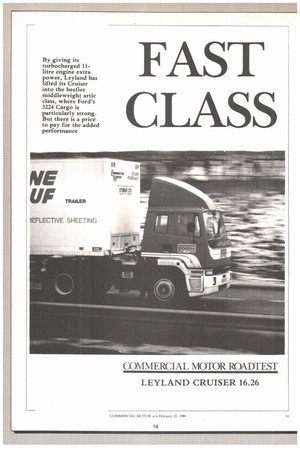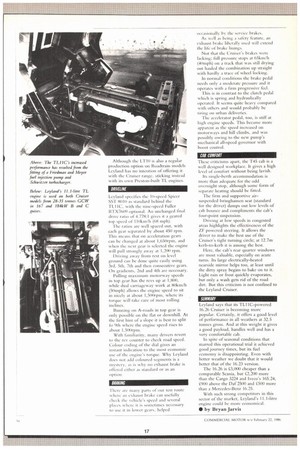FAST CLASS
Page 174

Page 175

Page 176

Page 177

If you've noticed an error in this article please click here to report it so we can fix it.
EIGHTEEN months ago Leyland raised the power and torque ratings of its turbocharged 11.1litre diesel, finally overcoming an apparent reluctance to join the manufacturing fraternity offering engines of 186kW (250hp) and above for 32.5 tonnes gross combination weight application.
As a result, the heavier end of the Cruiser range now has a choice of engines with 167 and 194kW(224 and 246hp) net outputs for use in attics of 28 to 35 tonnes gross weight and in drawbars too.
For this week's roadtest we have chosen the higher-powered 16.26 tractive unit, which since the 1984 Birmingham motor show has topped the Cruiser range — usurping the 16.23 which has now lost its 35-tonne plating.
Leyland's presence ill the market for tractive units over 28 tonnes GCW is far weaker than in most other commercial vehicle sectors, although last year it doubled its tractive unit sales to 558 to give it a 10 per cent share. This put it just ahead of Mercedes-Benz, but well behind Volvo's 18.8 per cent, Dal's 14.1 per cent and Scania's 13.5 per cent.
Demand for Cruisers this year has focused on higher-powered versions and Leyland is confident that this trend will continue.
According to the company, the extra power of its 11.1-litre engine has been achieved simply by replacing the earlier CAV Majormcc fuel injection pump with a Friedmann and Meyer unit. This move obviously has commercial advantages as Leyland has been using the Austrian-made equipment for over 12 years on the 400 series engines in the Freighter, the TLI IA, B and C engines and in its buses and coaches.
Also changed is the Holsett H2C turbocharger, which has been replaced by a Schwitzer. This is said to be more compatible with the new pump.
And to help reduce the higher temperatures resulting from the increase in power, Leyland now carries out an extra treatment of the cylinder heads. Any remaining sand residues from casting arc removed by Colenc salt washing. This is necessary only on TL11C engines.
PERFORMANCE
Whatever the reasons behind the changes, they have had the desired effects, increasing maximum net power by 9.8 per cent and torque by 7.4 per cent, both at the original peak revs of 1,800 and at 1,300 respectively.
Our test vehicle, a demonstrator with barely 14,000km on the clock, and coupled to our fully-laden box van semi-trailer, certainly felt very quick and vigorous, both on the test track and out on the roads.
Up to 80km/h it is a good deal quicker than Iveco's 165.24 and fairly comparable with the 3224 Cargo and Dar 2500. But its times through the gears show little improvement in pertininanee over the Cruiser we tested two years ago. — a 16.11 with the 167kW TL I1B engine and plated at 32.52 tonnes (CM, December 17, 1983)_ That vehicle turned in an extremely well balanced performance around our Scottish route. It returned 38.86 lit/100km (7.27mpg) at an average speed of (s5.38km/h (40.63mph) — quite a. good result considering it was run at the earlier restrictive speed limits of 65km/h (40 mph) On dual carriageways.
Like the previous test, this week's trial was carried out during wintry weather. But whereas two years ago we had a . little more than frost to cope with, the 16.26 had to contend with stronger, more variable winds and snow and slush-covered roads.
From Edinburgh southwards to Neville's Cross on the A167 our progress was hindered, with Carter Bar's southern side particularly hazardous. Although the snow plough had been through earlier it still needed a carefully controlled descent in 8th gear.
Strong side winds persisted for much of the third day and, although we achieved good journey times, this was at the expense of fuel economy, as the results on page 56 bear out.
As expected. the 16.26's overall average speed of 67.23kinlh (41.78mph) was much higher than that of the 16.23, although fuel consumption was worse, It 40.24 litilt/l/km (7.02mpg). Its speed was identical ro that of the Ford Cargo 3224 which set new fuel economy standards at 32.52 tonnes of 34.14 lit/100km (8.04mpg) (CM. March 23, 1985).
That was powered by the Cummins L-no-254I, an engine which Leyland already offers with the Constructor 2 (11x4) .dongside its own TLIIC, Gardrier's 6LXCT and Perkins' (neti. Rolls-Roycc) Although the ITIOis aIso a regu'l r production option on Roadtrain in dc Leyland has no intention of offering it with the Cruiser range, sticking instead with its own Preston-built TL engines.
Leyland specifies the 10-speed Spicer SST 8010 as standard behind the TL I IC. with the nine-speed Fuller wrx764N optional. Ail unchanged final drive ratio of 4.778:1 gives it a geared top speed of I ti)km/h ((i8 mph).
The ratios are well spaced out, with each gear separated by about 450 rpm. This means that on acceleration gears can be changed at about 1,65Orpm, and when the next gear is selected the engine will pull strongly away at 1,200 rpm.
Driving away from rest on level ground can be done quite easily using 3rd. 5th. 7th and then consecutive gears. On gradients. 2nd and 4th are necessary.
Pulling maximum motorway speeds in top gear has the revs up at I,FRXL while dual carriageway work at 80ktn/h (50mph) allows the engine speed to sit in nicely at about 1,50Orpm, where its torque will take care of most rolling inclines.
Running on A-roads in top gear is only possible on the flat or downhill. At the first hint of a slope it is best to split TO 9th where the engine speed rises to about 1,54111rpm.
With familiarity, many drivers revert to the rev counter to check road speed. Colour coding of the dial gives an instant indication to the most economic use of the engine's torque. Why Leyland does not add coloured segments is a mystery. as is why no exhaust brake is offered either as standard or as an option.
8R,1101C There .ire many parts of our test route Where an CNAIMIST brake can usefully check the vehicle's speed and several places where it is sometimes necessary to use it in lower gears. helped
occasionally liv the service brakes.
As well as being a safety feature. an exhaust brake liberally used will extend the life of brake linings.
Not that the Cruiser's brakes were lacking: full pressure stops at 65km/h (40mph) on a track that was still drying out hauled the combination up straight with hardly a trace of wheel locking.
In normal conditions the brake pedal needs only a moderate pressure and it operates with a firm progressive fi:el.
This is in contrast to the clutch pedal which is spring and hydraulically operated. It seems quite heavy compared with others and would probably be tiring on urban deliveries.
The accelerator pedal, too, is stiff at high engine speeds. This became more apparent as the speed increased on motorways and hill climbs, and was possibly owing to the new pump's mechanical all-speed governor with boost control.
C48 COlICORT
These criticisms apart, the T45 cab is a well designed workplace. It gives a high level of comfort without being lavish.
Its single-berth accommodation is more than adequate for the odd _ overnight stop, although sonic torm of separate beating should be fitted.
The firm and supportive airsuspended Isringhausen seat (standard for the driver) damps out low levels of cab bounce and compliments the cab's four-point suspension.
Driving at low speeds in congested areas highlights the effectiveness of the ZF powered steering. It allows the driver to make the best use of the Cruiser's tight turning circle; at 12.7m kerb-to-kerb it is among the best.
Here, the cab's rear quarter windows are most valuable, especially on acute turns. Its large electrically-heated nearside mirror helps too, at least until the dirty spray begins to bake on to it. Light rain or frost quickly evaporates, but only a wash gets rid of the road dirt. But this criticism is not confined to the Leyland Cruiser.
SbilitaPhr Leyland says that its TL1IC-powered 16.26 Cruiser is becoming more popular. Certainly, it otTers a good level of performance in all weathers at 32.5 tonnes gross. And at this weight it gives a good payload, handles well and has a very comfortable cab.
In spite of seasonal conditions that marred this operational trial it achieved good journey times, but its fuel economy is disappointing. Even with better weather we doubt that it would better that of the 16.23 version.
The 16.26 is 0,1100 cheaper than a comparable Scania, but C2,200 more than the Cargo 3224 and lvcco's 165.24, MO above the Daf 2500 and '501./ more than a Mercedes-Benz 16.25, With such strong competitors in this sector of the market, Leyland's 11.1-litre engine could he more economical.
• by Bryan Jarvis
































































































































































































